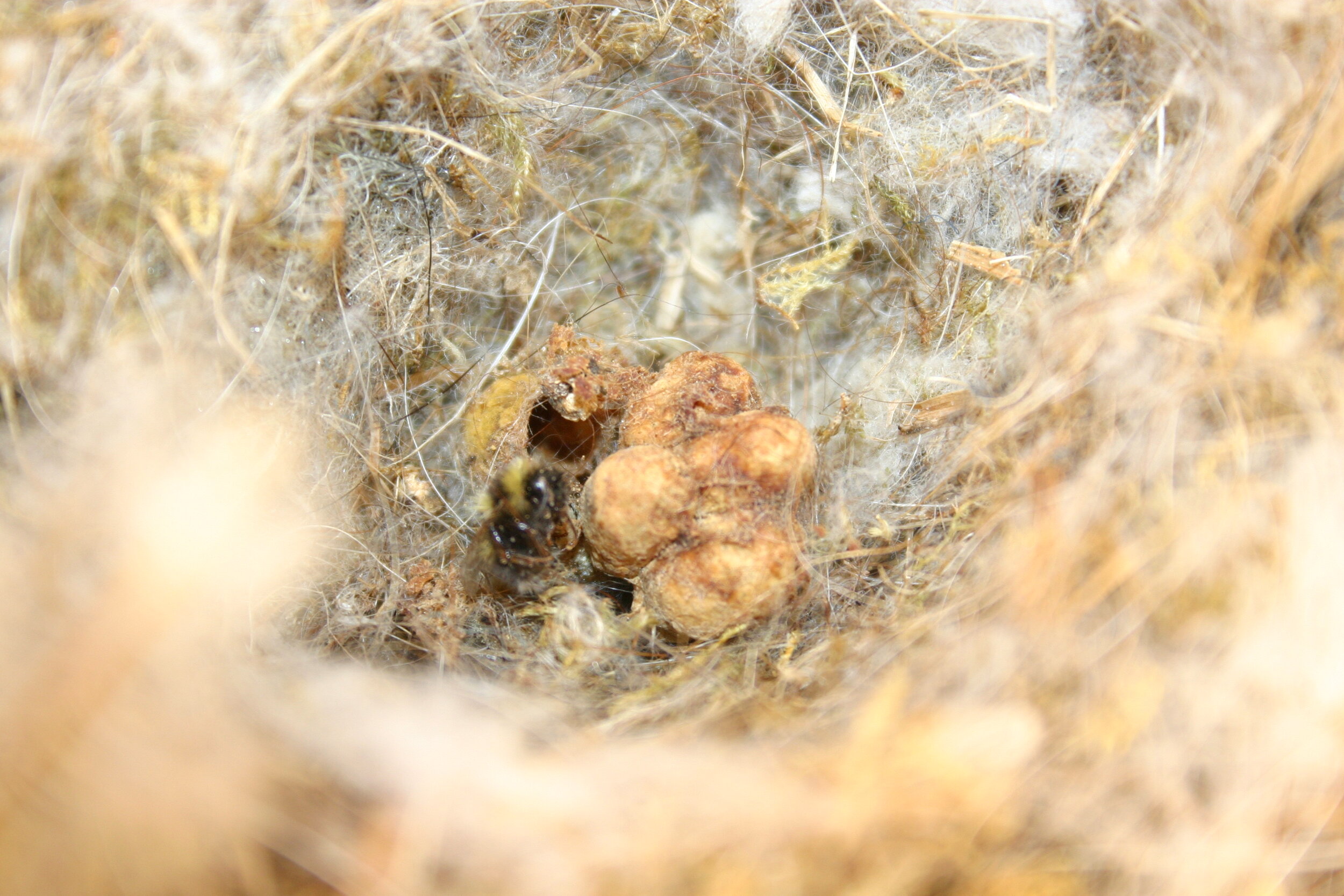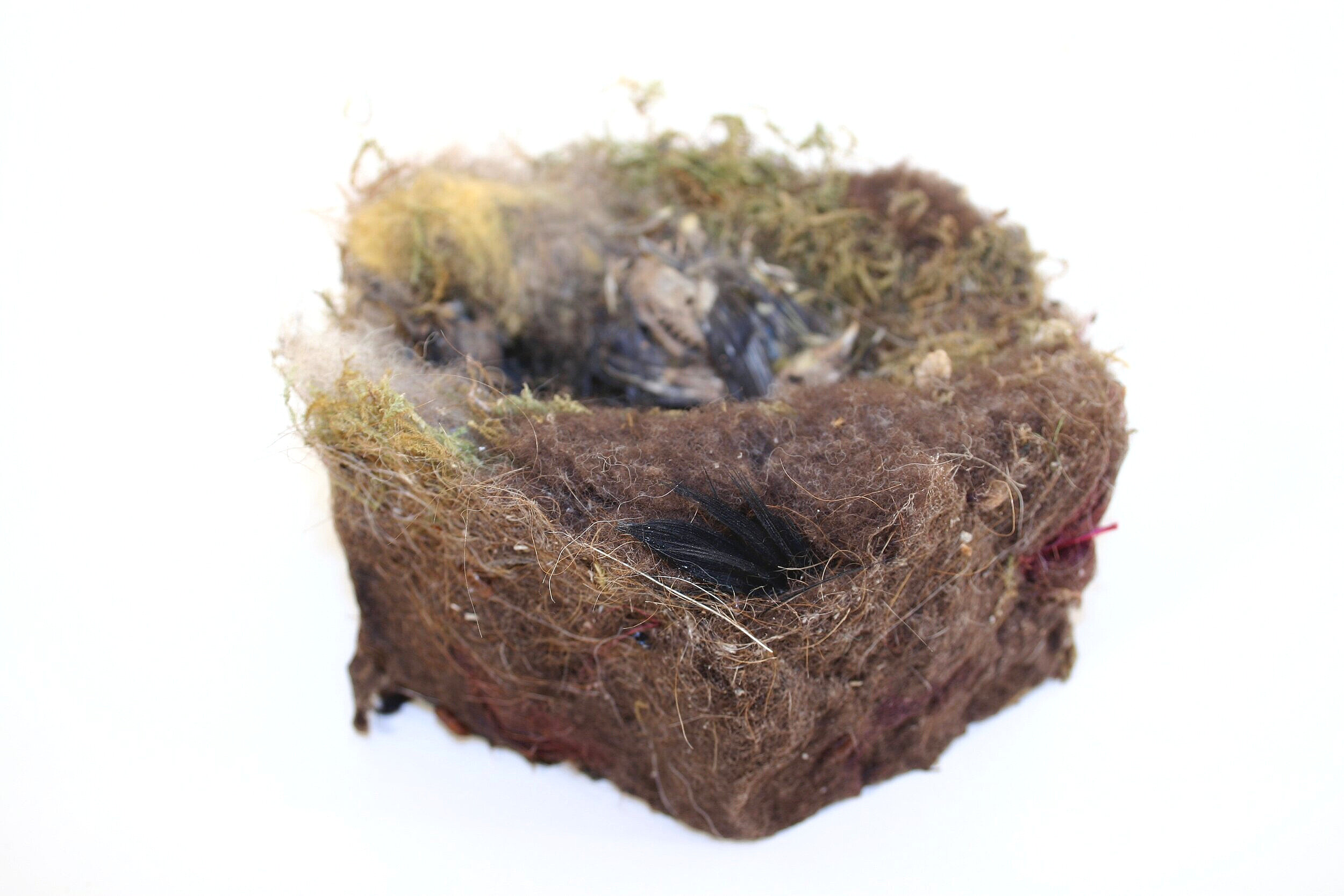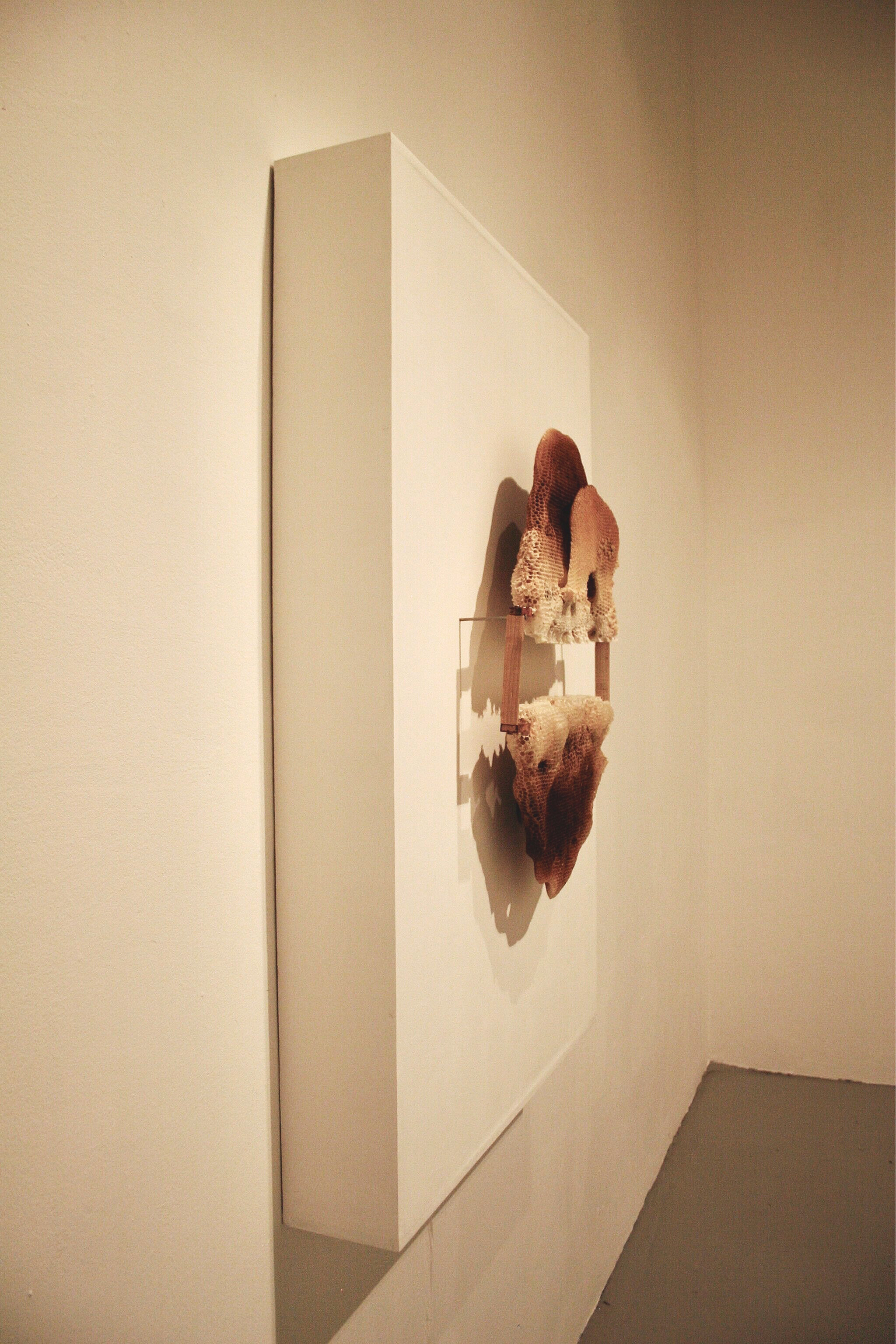Hexagonal Nests 2010-2012
Take away Nesting Boxes for gallery visitors, made from repurposed cardboard & ecopaint
My doctoral research in the Burren centered on the expansion and implementation of the ecological notion outside the traditional scientific investigation of ecology. I argued that the concept of ecology could be applied as a theoretical framework to analyze the function of an individual artwork. For me, addressing the ecology of an artwork means examining the interdependence and interrelation of materials, the creation process, the intended concept and the finished artwork. Central to my initial investigation of the concept of ecology was the synthesis of the elements; specifically the use of organic materials to create sculpture that represented one aspect of humanity’s relationship to the natural world.
In order to experience, and not simply study ecology, it became necessary for me to engage and interact with the ecosystems and the biodiversity of life within the Burren. I wanted to create art that had a beneficial impact on my surrounding environment. More than that, I wanted to create art in conjunction with my surrounding environment. From this crystallization of my intention, I listed the aims of my enquiry to include the following: to examine current ecological concerns; to determine the issues that are within my power to change; to initiate accessible solutions that are relevant, meaningful and sustainable not only for myself but for others as well; to employ materials and processes in ways that exemplify my research; to create work that has impact within and outside of an art context. It was also critical that the process and final artwork should contribute solutions at a fundamental level of intervention. In these ways the enquiry’s focus on ecology was clarified.
As a sculptor, I became interested in the idea that I could potentially build or sculpt with animal species. Many animals build. Spiders construct intricate webs; beavers build dams; terrestrial and aquatic invertebrates build their own shells and caterpillars weave cocoons. However, the potential for interaction with these species seemed limited given the indeterminate locations of their construction. Also as I was interested in positively affecting environmental change, I felt that I needed to work with priority species in order reinforce the ecosystems of the Burren. As the previously mentioned species are not keystone[1] or priority species[2] I sought out animals that were. Research into ecology, ecosystems and the biodiversity of the region revealed to me the importance of honeybees, Blue Tits and Great Tits. Importantly, these particular animals ‘build’ and do so within artificial habitats, or purpose built habitats, in this case nesting boxes and beehives. I thus realized the potential to collaborate with them inside these habitats in order to create sculpture. Although the term collaboration applied to my engagements with honeybees and birds may be seen as an unconventional use of the term, I maintain that it is the closest approximate term to describe the ecologically-based, reciprocal relationships developed as part of my artistic practice.
In the early winter of 2010, I built a series twenty-five nesting boxes, each in the shape of a hexagon, for Blue Tits and Great Tits and located them throughout the Burren . The number of nesting boxes was determined by the time it took to connect with an Irish company who milled sustainably sourced wood, to build the boxes and to find suitable locations throughout the Burren. The shape, found throughout nature is evocative of the interconnectedness of an ecological system. Importantly, at the end of each nesting season the nests must be cleared out of the nesting boxes in order to prevent an infestation of lice, mites, slugs and general dampness. The birds do not return to the nesting box the following season if their dwelling is in anyway less than ideal. When the nest is removed, it is formed in the shape of a hexagon as dictated by the sides of the constructed nesting box.
During the 2011 and 2012 nesting seasons I placed various fabrics outside and inside the nest boxes. The materials included such as raw silk, dyed wool, yarn and brightly colored feathers. The birds then built their nest on top of and amongst these materials. These sculptural collaborations are the result of voluntary participation - or non-participation - on the part of the Blue Tits and Great Tits. Although the birds and I share an ultimate goal, which is a nest built inside the nesting box and the procreation of the species; the creation process involves relinquishing a large degree of control over the final outcome both on the part of the birds and humans. However, this allows for simultaneous convergence and juxtaposition of the human and non-human methods of creation. For the birds, the nest functions as a sheltered environment to lay eggs and rear their young. When the birds abandon their nest, the nest’s function has been fulfilled. For me as an artist, the abandoned nest brought into an exhibition context exists as an art object that is simultaneously symbolic of, as well as a byproduct of the reciprocal relationship between the birds, myself and the ecology of the Burren.
Honeybees are also vitally important to the biodiversity of the natural environment and to humans as well. As the main pollinators of this planet they contribute to the production of over one third of all the food we as humans consume. They are, in part, responsible for over one third of all the food humanity consumes.[3]. Currently, Colony Collapse Disorder or CCD, has had a devastating impact on worldwide honeybee populations particularly in the United States but also in France, Belgium, the Netherlands, Italy, Greece and Spain. Emerging in 2006, CCD is a phenomenon characterized by a rapid collapse in which the vast majority of the adult bees disappear from the hive.[4] ther attributes of CCD include the lack of significant numbers of dead bees found in or around the hive, plenty of honey and pollen stores, and capped brood comb. It is as if the hives have simply disappeared. The causes of colony collapse disorder are related to combination of circumstances including the invasive varroa mite, diseases such as Nosema, malnutrition, pesticides and migratory beekeeping.
Although no cases of CCD to date have been reported in Ireland there have been significant problems attributed to the varroa mite that are thought to be responsible for the spread of deformed wing disease and acute bee paralysis virus.[5] Accidentally imported, the first case of the varroa mite was identified in County Sligo in the late 1990’s and has continued to spread nationwide. However, it bears repeating that a solution, which counters the effects of habitat fragmentation and destruction, could be the building of artificial or purpose built habitats such as nesting boxes, beehives, and bat boxes for priority species. Honeybees are such a species and non-commercial or small-scale beekeeping within constructed habitats supports the biodiversity of their surrounding ecosystems.
Maintaining a beehive is completely different from maintaining the nesting boxes. Each nesting season the nesting boxes go out in sometime in the first two months of the year and depending on their location, I do not see them again until late June. Although one season I installed a nesting box camera in a nesting box in the backyard, the sightings of the birds are rare and brief as they dart in and out of the box. Every time I inspect the hive, however, I am in direct contact with the honeybees. As every beekeeper will tell you, the bee suit is not a barrier against every sting. The hum of the bees, the activity of their flight circling around me, the earthy smell of wax and honey, the banana-candy smell of the bee venom, all add up to an immediate and very visceral experience.
As a beekeeper, I have adopted a method called Barefoot Beekeeping[6], which is an alternative approach to commercial beekeeping. The term barefoot is used as a metaphor for a simplistic, sustainable approach to small-scale beekeeping using top bar hives (Figure 11). In a top bar hive, the bees build comb as they would in the wild, in wide tear drop formations. As there are no frames and no prefabricated wax foundation used, this process has a much greater potential for the creation of sculptural form. In order to make visible the juxtaposition of the human and non-human methods of creation as well as the reciprocal nature of the relationship between the bees and myself, I make gentle interventions and aesthetic adjustments to encourage the bees to build irregular sculptural forms. Within the hive, honeybees like to maintain what is typically called a ‘bee space,’ or approximately 1 cm between the frames of comb. Knowing the preference that bees have for this, I spaced the frames about 2 cm apart to encourage the bees to build a second layer of comb onto a single top bar. The result is the lighter colored second tear shape. Secondly, I limited the amount of empty bars within the hive. The bees searching for an area to build honeycomb built on top of the bar resulting in the white crown like structure on the top bar (Figure 13).
For the sculpture in Figure 14, I placed two frames together in a mirror image. The rectangular space in between the two combs represents the dimensions of a traditional honeycomb frame. Each mounted box contained a small speaker that played a sound recording of the process of beekeeping combined with the hum of the colony. The hexagonal cells surprisingly enhance the recordings, creating a doubled amplification effect.
As a result of the sculptural and ecological engagements, the population of the Irish Black Honeybee has bolstered and, at a modest level, so has the biodiversity of my surrounding environment. For me, the work is a model for engaged and informed interaction with the natural world; one that is not one side or self-interested but that is sustainable and mutually beneficial. It is my hope that viewers would be inspired to develop this relationship for themselves. This could take the form of habitat building, leaving an area in the yard wild, a reduction in pesticide use or ideally beekeeping. The sculptures created in collaboration with the honeybees and birds not only highlight the importance of these priority species, they offer an alternative potential for expanding traditional notions of landscape representation and artistic practice.
Before attempting to represent a relationship to a particular area of the natural world, especially the Burren, artists must first seek to understand the interwoven ideologies of place. I pose the question, both to myself and the students, How does an artist engage with such a visual arresting landscape? What comment or contribution can be made beyond appreciation or glorification? We begin by looking beyond the immediate visual impact to try to understand the ecology of this intriguing and complex place. Artwork created in the Burren, both my own is not necessarily a visual representation of the surrounding ecology. Rather, it is a reflection of humanity’s relationship to the more than human world; it is interconnected, interrelated, complex and continually evolving – much like the ecology of the Burren itself.
[1] A keystone species is disproportionately influential in relation to its abundance as its survival impacts the survival and abundance of many other species within a given ecosystem. Its removal or decline results in a significant shift in the ecology of a community and sometimes the physical structure of an environment. ‘Keystone Species,’ University of Illinois at Urbana-Champaign Website. http://www.life.illinois.edu. Accessed May 5, 2011.
[2] According to the Joint Nature Conservation Committee of the UK government, priority species are species of high conservation value for reasons that include their inherent value to their surrounding environment, having suffered a significant population decline in the past, or that their habitats are limited to a specific range. Joint Nature Conservation Committee Website. http://jncc.defra.gov.uk. Accessed May 4, 2011.
[3] In terms of weight, 35% of the world food production comes from crops which depend on insect pollination.”( National Biodiversity Data Centre. http://www.biodiversityireland.ie.) These crops include the majority of fruits, vegetables, oil and protein plants, nuts, spices and stimulant crops like coffee and cocoa. However, the Food and Agricultural Organization of the United Nations (FAO) recently “estimated that out of 100 crop species which provide 90% of food worldwide, 71 of these are bee-pollinated.” (National Biodiversity Data Centre Website. http://www.biodiversityireland.ie.)
[4] Ross Conrad, Natural Beekeeping: Organic Approaches to Modern Apiculture. (White River Junction: Chelsea Green Publishing, 2007), 225.
[5] Richard Jones and Sharon Sweeney-Lynch, The Collins Beekeeper’s Bible: Bees, Honey, Recipes and Other Home Uses (United Kingdom: HarperCollins Publishers, 2010), 149.
[6] P. J. Chandler, The Barefoot Beekeeper, p. 8.






















